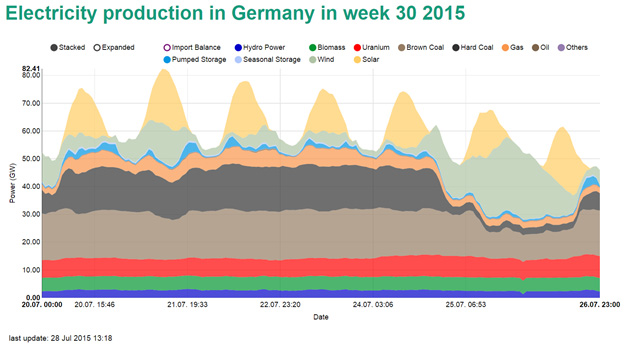New renewable electricity records in Germany in Japanese
and lead author of GermanEnergyTransition.de.
In July, the share of renewables reached 78 percent of demand for a few hours – higher than ever before. Likewise, more solar power was probably produced than nuclear power last month. In light of the skepticism about renewable energy until recently, both records are worth celebrating – though they are otherwise only symbolic. Germany still has its work cut out for it.
On July 25, renewables made up 78 percent of electricity demand for several hours. Because it was a Saturday, power consumption was relatively low. In addition, an unusual combination of sunny weather in the south and windy weather in the north meant that both solar and wind power production were simultaneously fairly strong. The weekly overview below also shows that wind and solar power can drop very low, such as to around 2-3 gigawatts in the wee hours of July 22. Yet, when biomass and hydropower are included, renewables still made up nearly 25 percent of domestic demand at the time. Note that the chart below includes power exports, which would need to be subtracted to determine domestic power demand.

Source: Energy-Charts.de, Fraunhofer ISE
Speaking of power exports, the event also showed how inflexible nuclear reactors are; German spot power prices were lower than in France at the time, but France was unable to take advantage of the price spread because it could not ramp down its nuclear reactors further.
German nuclear had already fallen to an unusual low. In June, another nuclear plant closed permanently, leaving the country with only eight – and three of those were off-line during at least part of July for scheduled maintenance and refueling. As a result, only half as much nuclear power was generated as was in January, for instance.
Though the record for solar power production from July 2013 has yet to be broken, July 2015 was another strong month. Initial estimates indicate that roughly the same amount of solar and nuclear power was generated that month, with solar slightly in the lead (by less than 1%). However, the margin of error for these live estimates is greater than the difference between nuclear and solar, so we will have to wait (unfortunately, until September 2016) for official figures to confirm that July 2015 was the first month in which Germany produced more solar power than nuclear power. (Live statistics are just guesstimates because total power production is extrapolated from measurements of most, but not all, generators.)
Still, renewables only make up 11-12 percent of total energy demand, most of which is not electricity at all, but oil for heat and transport. Nonetheless, each record that is set is another nail in the coffin of the pro-nuclear naysayers, who told us 20 years ago that more than four percent renewable electricity would not be possible. In the first half of this year, renewables made up 32.5 percent of power consumption – up from 27 percent in 2014. And with a lot of offshore wind power in the pipeline, expect that percentage to continue to grow swiftly. Germany is in the process of proving that renewables can grow faster than anyone thought – so fast, even during the nuclear phaseout, that coal power dropped in the first half of this year by nearly 3 percentage points.
Craig Morris (@PPchef) is the lead author of German Energy Transition. He directs Petite Planète and writes every workday for Renewables International.

